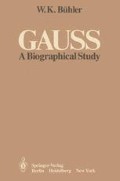Abstract
The second Brunswick period, from 1798 to 1807, was decisive for Gauss’s further development. He learnt to assess his powers, to select areas of research to which to devote his time and energy, and to assert himself in the scientific world. His development was not confined to the theoretical or scientific sphere; when reaching out in this way, Gauss was faced with the question of what attitude he should choose when dealing with students or colleagues who sought his advice. Very soon it must have been clear to him that he could not expect to benefit substantially from such discussions and exchanges of opinion; almost always he was at the giving and not at the receiving end. It may have been a temptation, but Gauss never chose to close himself off and dissociate himself from ordinary scientific exchanges. He was very well aware of the obligation of the genius to explain (himself) and to present subjects which he himself was able to penetrate quickly in a way that was accessible to a wider audience. He accepted as a “partner” or colleague anyone in whom he could perceive honest effort and interest. The correspondence, particularly with Schumacher and Gerling, provides the best examples, but there other instances like the extraordinary posthumous essay „Zur Metaphysik der Mathematik“.1 Today, one would call it a didactic paper dealing with “foundational” questions like the definitions of addition and multiplication.
Access this chapter
Tax calculation will be finalised at checkout
Purchases are for personal use only
Notes
G.W., Vol. XII, pp. 57ff.
See letter #27 to Bessel, of Nov. 13, 1814, or letter #98 to Olbers, of Dec. 3,1808. Gauss changed his opinion in the case of Lindenau. Initially, he did not take him seriously, but accepted him later as friend and colleague. (See Letter #61 to Olbers, of July 2, 1805.)
The journal’s exact name was Commentationes societatis regiae scientiarum Gottingensis recentiores.
… Da in dem angeführten Werke die Untersuchung so weit bereits geführt, und nur die Bestimmung des Zeichens für irgend einen Werth von k noch übrig war: so hätte man glauben sollen, dass nach Beseitigung der Hauptsache diese nähere Bestimmung sich leicht wüde ergänzen lassen, um so mehr, da die Induction dafür sogleich ein äusserst einfaches Resultat gibt: für k = 1, oder für alle Werthe, welche quadratische Reste von n sind, muss nemlich die Wurzelgrösse in obigen Formeln durchaus positiv genommen werden. Allein bei der Aufsuchung des Beweises dieser Bemerkung treffen wir auf ganz unerwartete Schwierigkeiten, und dasjenige Verfahren, welches so genugthuend zu der Bestimmung des absoluten Werths jener Reihen führte, wird durchaus unzureichend befunden, wenn as die vollständige Bestimmung der Zeichen gilt. Den metaphysischen Grund dieses Phänomens (um den bei den Französischen Geometern üblichen Ausdruck zu gebrauchen) hat man in dem Umstände zu suchen, dass die Analyse bei der Theilung des Kreises zwischen den Bögen ω, 2ω, 3ω … (n − 1)ω keinen Unterschied macht, sondern alle auf gleiche Art umfasst; und da hiedurch die Untersuchung ein neues Interesse erhält: so fand Hr. Prof. Gauss hierin gleichsam eine Aufforderung, nichts unversucht zu lassen, um die Schwierigkeit zu besiegen. Erst nach vielen und mannigfaltigen vergeblichen Versuchen ist ihm dieses auf einem auch an sich selbst merkwürdigen Wege gelungen... (G.W. II. p. 156)
The relevant reviews are in Vol. IV of G.W.
See Vol. XII of G.W.
Untersuchungen über die Eigenschaften der positiven ternären quadratischen Formen; Gauss’s review is in Vol. II of G.W
Disqu. Ärithm. §272.
Author information
Authors and Affiliations
Rights and permissions
Copyright information
© 1981 Springer-Verlag New York Inc.
About this chapter
Cite this chapter
Bühler, W.K. (1981). Gauss’s Style. In: Gauss. Springer, Berlin, Heidelberg. https://doi.org/10.1007/978-3-642-49207-5_14
Download citation
DOI: https://doi.org/10.1007/978-3-642-49207-5_14
Publisher Name: Springer, Berlin, Heidelberg
Print ISBN: 978-3-642-49209-9
Online ISBN: 978-3-642-49207-5
eBook Packages: Springer Book Archive

